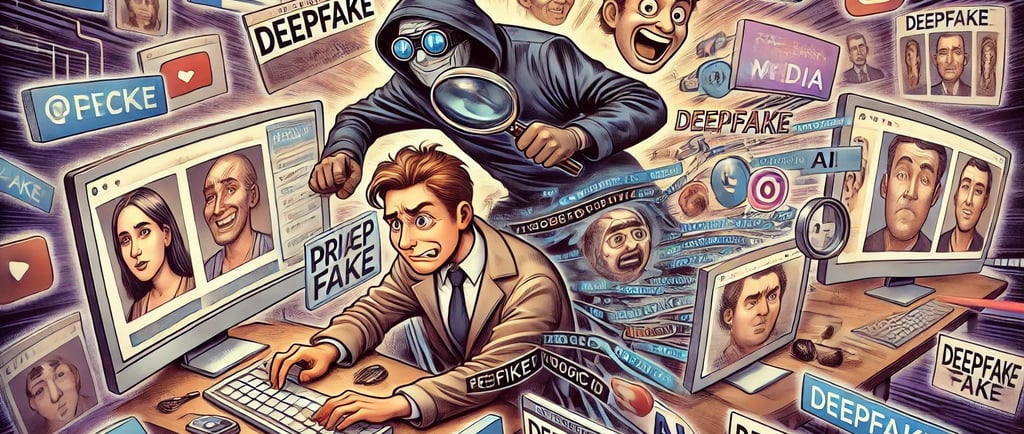Deepfake Detection and Media Verification: Challenges and Solutions in Private Investigation
Explore the challenges and solutions in detecting deepfakes in private investigations. Learn about technological advancements, case studies, and the evolving role of investigators in combating digital deception.


In the modern era, where digital content can be manipulated with unprecedented ease and sophistication, the field of private investigation has encountered a new battleground: the detection and verification of deepfakes. These synthetic media creations, powered by artificial intelligence, pose significant challenges to privacy, security, and truth in both personal and corporate contexts. This article explores the intricacies of deepfake detection, recent case studies, technological advancements, and the evolving role of private investigators in navigating this deceptive landscape.
The Rise of Deepfakes
Deepfakes, once a novelty, have rapidly evolved from amusing digital curiosities to tools of serious misinformation and fraud. By utilizing machine learning algorithms, particularly Generative Adversarial Networks (GANs), deepfakes can now produce videos and audio that are increasingly difficult to distinguish from authentic content. The accessibility of this technology has lowered the entry barrier for creating false media, leading to widespread concerns over its use in scams, political manipulation, and personal sabotage.
Case Study: A Business Owner's Ordeal with Deepfakes
A recent case underscores the seriousness of this issue, where a local business owner became the target of a malicious deepfake campaign. Unknown to him, an individual began creating and spreading deepfake videos across social media platforms like X (formerly Twitter) and Instagram, using his likeness to endorse falsehoods and engage in fictitious activities that damaged his reputation and business.
The investigation into this matter involved:
IP Address Tracking: Using open-source intelligence, private investigators traced the origin of the deepfakes through IP addresses linked to the initial uploads. This digital footprint led them to a disgruntled former employee with both the motive and means to carry out the attack.
Deepfake Analysis: Forensic analysis of the videos involved examining frame-by-frame inconsistencies, synchronizing audio-visual elements, and comparing them to known real videos of the business owner. Advanced tools were employed to detect signs of manipulation that are invisible to the naked eye, such as inconsistencies in facial movements or unnatural blinking patterns.
Social Media Investigation: By analyzing the social network around the spread of these deepfakes, investigators mapped out the individuals who interacted with or shared the content, revealing broader implications of coordinated misinformation campaigns.
Technological Advances in Deepfake Detection
Fighting deepfakes involves both human expertise and cutting-edge technology:
AI-Driven Detection: Modern detection tools use AI to analyze videos for signs of manipulation. These systems are trained on vast datasets of both authentic and manipulated media, learning to spot anomalies in skin texture, eye movement, or voice inconsistencies.
Blockchain for Verification: Some solutions propose using blockchain technology to timestamp and verify the authenticity of videos at the moment of creation, creating a verifiable history that can prove the origin and integrity of media content.
Metadata Analysis: Beyond the video itself, metadata such as geolocation, timestamps, and camera information can be cross-referenced against known data to verify authenticity or detect manipulation.
Challenges in Deepfake Detection
Despite technological advancements, several challenges remain:
Realism of Deepfakes: As technology improves, deepfakes become harder to detect. The latest models, like Meta's Sora and Google’s Imagen Video, are pushing the boundaries of what's possible, making detection more complex.
Data Privacy Concerns: Effective detection often requires access to personal data, raising significant privacy issues. Striking a balance between privacy rights and the need for verification is a delicate challenge.
Legal and Ethical Boundaries: The legal frameworks around what constitutes the illegal use of deepfakes, especially across borders, remain murky. Private investigators must navigate these waters carefully to avoid infringing on rights while uncovering the truth.
The Role of Private Investigators
In this landscape, private investigators are not just detectives; they are also digital forensic experts. They:
Educate and Inform: They serve as educators, helping clients understand the risks of deepfakes and how to protect themselves.
Verify and Authenticate: They authenticate media for legal proceedings or corporate credibility, often under tight deadlines.
Advocate for Legislation: There is a growing need for private investigators to engage with policymakers to create robust laws against the malicious use of deepfakes.
Conclusion
The battle against deepfakes in private investigation reflects broader societal struggles with technology and truth. While tools and methods evolve, the core remains the human element—judgment, ethics, and the relentless pursuit of truth in an age where reality can be easily fabricated. As seen in the business owner's case, private investigators are at the forefront of this battle, employing a mix of technology, human insight, and legal acumen to navigate the murky waters of digital deception. The future will likely see even more sophisticated deepfakes, necessitating continuous adaptation and innovation in private investigation to keep pace with, or preferably stay ahead of, this technological arms race.


